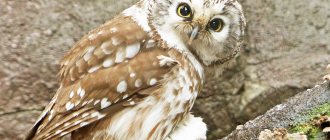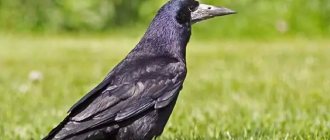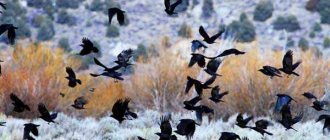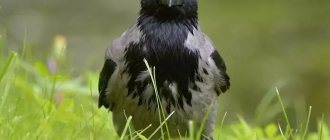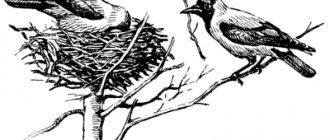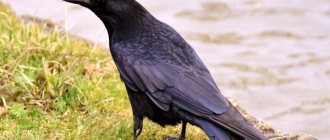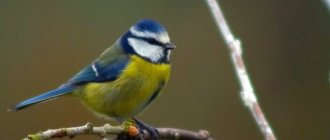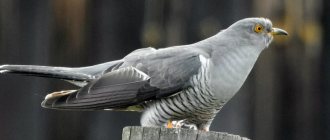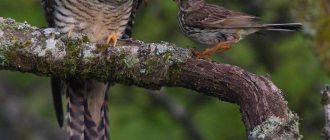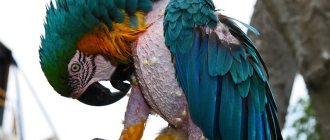- May 18, 2019
- Birds
- Sergey Nikolaev
It is unlikely that many of us, ordinary citizens or rural residents not burdened with knowledge of ornithology, can immediately determine which bird perched on a tree in the yard of the house - a rook or a crow. Why? After all, in reality, these are two completely different, although similar birds. There is something that causes constant confusion, and there are features that separate these birds. This article is devoted to how to find differences between rooks and crows.
First, let's briefly tell you what these birds look like.
Appearance
These representatives of the corvid family have an elongated and slender body ranging from 40 to 45 cm in length. The wings have a span of approximately 85 cm, and half the length of the body is the tail. An adult weighs approximately 500-600 grams.
The thin, long-legged bird has a beak of appropriate length. The shiny black plumage has a blue tint, underneath there is gray down that retains body heat. Rooks lubricate their plumage with skin secretions, which makes them waterproof.
The flight speed is about 85 km/h, thanks to the ideal aerodynamic body. Birds do not soar, but fly, making frequent flapping movements of their wings. They take off without a run. They have very powerful muscles, making up approximately 18 percent of their mass. Another 12 percent of the weight comes from the rather large heart.
Jackdaw
To understand how a jackdaw differs from a crow, it is worth considering the special characteristics of this bird. Typically, jackdaws have a body length of 34-39 centimeters. Weight does not exceed 280 grams. The main feature by which these two birds can be distinguished is the color of the plumage and size.
Jackdaws are black in color, but the head and chest are mostly silver-gray. Birds' eyes are light, may be greenish or blue. The iris is almost white. Since this bird needs a roof over its head, it lives near those houses where there are loopholes into the attic or ventilation holes. Usually these birds “huddle” in flocks and are often found with rooks, which, by the way, are also confused by some with crows.
Birds familiar to us are indeed very similar. The main differences between the jackdaw and the crow are the color of the plumage and size.
The body length of the jackdaw is 35-39 cm. Its weight reaches 280 grams. On the head and chest area of jackdaws, the feathers have a grayish tint with a silver tint. The rest of the body is covered with black plumage. The eye color is light green and light blue.
Both species of birds lead a similar lifestyle and have a common habitat. Nesting sites of birds close to humans were chosen because these creatures need a roof over their heads and food. Therefore, their flocks are found in abandoned buildings, city parks and residential buildings.
We suggest you read: How to recognize magpie tracks
Difference between adult and young birds
The thin but extremely strong beak allows the rook to easily handle the nut peel. Young birds have a black beak, which lightens to gray over time. At the base of the beak there is a special throat pouch that serves to carry food to the chicks.
Young rooks have small feathers in this place, which also disappear with age. Scientists believe that the shedding of these feathers helps adult birds determine the outside temperature. There is also a version that an area without feathers is easier to clean, since the bird’s diet is based on waste. By washing the bare area, the rook gets rid of possible infections.
Externally, young birds are quite similar to black crows. They differ only in their elongated and thinned beak, as well as feathers on the body and legs directed in all directions.
photo of rooks
Magpie
Magpies belong to the family "corvids" and belong to the genus Magpies. Ravens are considered to be of the genus “raven”.
The habitat of magpies is wider than that of their relatives. In contrast, magpies live not only in Eurasia, but also in North Africa and North America.
The weight of a magpie is 200-230 grams, the body length of an adult is 50-51 cm. It differs from other brethren in the color of its plumage. The wings, tail, back and head of the bird are black. But the sides, ends of the wings and abdomen are painted in contrasting white.
Another feature of magpies is the way they sing. It is not characteristic of its closest relatives. The range of sounds produced by birds is expressed in chirping. It clicks, crackles, groans and even hisses.
In flight, they are most often alone, since they are not prone to forming flocks.
The magpie is a real beauty with contrasting black and white plumage. But, surprisingly, many can still confuse it with other crows. Therefore, it will be interesting to consider how a crow differs from a magpie, because their size, beak and shape are similar in everything. This white-sided bird is also about 50 centimeters long and weighs just over 200 grams.
Diet
Rooks are omnivorous. They hunt with equal zeal for eggs, larvae and insects themselves, searching for them with their elongated beak. The summer diet includes small reptiles, amphibians, large beetles and worms. When there is a lack of natural food, they easily rummage through waste in landfills.
Large flocks of rooks can become a real scourge for cultivated plants. Birds can easily destroy grain crops, peck seedlings and berries, and dig up only grain thrown into the ground. In spring, even a few dozen rooks can cause significant damage to a vegetable garden or garden.
Habitats
You can meet rooks throughout the European continent, including Scandinavia. It is not uncommon in the vast expanses of the post-Soviet countries, in Asia and even New Zealand. In the eastern and northern regions of Russia, birds are rare and do not create large colonies.
Nesting usually occurs near human habitation on flat areas. The nest is located on high ground, such as power poles, roofs of buildings and tall trees. During the period between hatching, chicks usually roam close to farmland.
Differences between rooks and crows
These representatives of the same family are often confused with each other, although the birds are completely different. The lifestyle of crows and rooks is significantly different. Crows are considered the largest representatives of corvids, having a body weight of up to two kilograms, while the rook is much smaller and weighs only 600 grams.
The main differences are:
- The gray-brown beak of the rook versus the black beak of the raven.
- The raven is a solitary bird, while rooks live in flocks.
- Among rooks there are migratory individuals, while crows lead a sedentary lifestyle.
- In flight, the raven resembles predators. The rook is a typical representative of corvids in this regard.
- Crows have more developed intelligence.
- The preferred food of ravens is carrion. The main diet of rooks is insects and worms.
- Ravens have a longer lifespan.
- Crows have the ability to copy voices, including human speech.
photo of a rook in flight
What's the difference?
So, having learned about the characteristics of these two birds, you can understand how a raven differs from a crow. Let's start with the fact that it is practically impossible to meet a raven in the city, since these birds try to stay away from humans. Crows, on the contrary, often circle around the city in search of nuts and other delicacies. Also, the flight of the first bird is very similar to the gliding of a predator; none of this family has such a feature.
In addition, another difference is noticeable in flight: if you look at the tail, the crow’s tail is straight, while the raven’s is wedge-shaped. Also in the pictures you can see the difference between a raven and a crow. The photo shows the size of both birds. Yes, the crow is slightly smaller than its relative. In addition, if a raven can only be black, then a crow can be gray.
Intellectual capabilities
The intellectual abilities of this species are quite high. Good thinking, the ability to build logical connections, and developed visual memory will distinguish these birds in the world of birds. Each rook is constantly learning, accumulating acquired experience and applying it to his business. Having once remembered a certain person, the rook can recognize him even after several years.
A bird can easily use a reed to get food from a bottle with a high neck or use it to pick out food from a narrow crack. The rook is able to bend or twist a stick to get the desired delicacy from a hard-to-reach place.
A number of experiments have proven the ability of birds to distinguish colors. Rooks are able to wait for a red signal at a traffic light, waiting for the cars to come to a complete stop. Only then do they calmly collect the previously scattered treats on the roadway.
The ability of birds to communicate non-verbally has also been proven. It is easy to observe rooks sitting on wires, passing various objects to each other: sticks, specks and others. Having found something valuable, one of the members of the pack will definitely boast of his find to the rest of his relatives.
Among the younger generation, various games are very common. This can be a kind of “tag”, “catching up”, swinging on wires and branches, or competitions for the possession of an attractive thing: a beautiful pebble, branch or stick.
smart bird rook
Bibliography
- Asoskova N.I., Amosov P.N. On the biology of reproduction of the rook Corvus frugilegus in the city of Arkhangelsk: scientific article. – Russian Ornithological Journal, 2022, vol. 27, express issue 1651, p. 3848 – 3850.
- Boehme L.B. The life of birds at our home. − 3rd ed. − M.: Lesn. Industry, 1987, p. 152.
- Brezgunova O. A. Cooperative reproduction in corvid birds: scientific article. – Zoological Journal, 2015, v. 94, No. 1, p. 90-105.
- Grichik V.V., Burko L.D. “Fauna of Belarus. Vertebrates: textbook. manual" Minsk, 2013. -399 p.
- Yurko V.V. “Wintering of the rook (Corvus frugilegus) in Minsk and possible reasons for the formation of its sedentism” / Subbuteo No. 10, 2011. P.51-53.
- Ivanovsky V.V. “Raven Corvus corax in the north of Belarus in 1999-2014” / Russian Ornithological Journal 2022, Volume 26, Express issue 1436: 1673-1682Koblik E.A. Diversity of birds (based on materials from the exhibition of the Zoological Museum of Moscow State University), Part 3. - M.: from Moscow State University, 2001, p. 360.
- Konstantinov V. M. Features of synanthropization and urbanization of corvid birds: scientific article. – Russian Ornithological Journal, 2015, vol. 24, Express issue 1177, p. 2892-2901.
- Paevsky V. A. On the etymology of Latin names of birds: scientific article. – Russian Ornithological Journal, 2016, vol. 25, p. 3527-2536.
- Podyapolsky N. Birds of the raven family: ed. S. A. Buturlina. – M.: Life and knowledge, 1933, p. 68.
- Rakhmanov A.I. Talking raven birds. Maintenance, care, training. − M.: Aquarium-Print LLC, 2004, p. 64.
- Romanova V.A., Razbesov O.K. Pigeon farming. M.: Agropromizdat, 1987, p. 208.
- Stepanyan L. S. Abstract of the ornithological fauna of the USSR. – M.: Nauka, 1990, p. 728.
- Bird CD, Emery NJ Rooks Use Stones to Raise the Water Level to Reach a Floating Worm Current biology: CB 19(16):1410-4 September 2009
- Fransson, T., Jansson, L., Kolehmainen, T., Kroon, C. & Wenninger, T. (2017) EURING list of longevity records for European birds
- Savage C. Crows: Encounters with the Wise Guys of the Avian World, - Vancouver: Greystone books, 2005, p. 120
- https://www.hbw.com/species/rook-corvus-frugilegus
- https://ru.wikipedia.org/wiki/Rook
- https://www.itis.gov/servlet/SingleRpt/SingleRpt?search_topic=TSN&search_value=179738#NULL
- https://www.iucnredlist.org/species/22705983/118782308
Author of the article: Yulia Varazhbit, ecologist
Did you like the article? Share with your friends:
Migrations and habitat
Rooks are migratory birds. In warm weather, they easily change their habitat in search of food. In the process of moving across fields and lands, the flock takes in other rook families. By autumn, such flocks can number millions of birds.
With the onset of autumn, birds gradually move south. In warmer regions, they fly away for the winter only in early November, gradually moving south. Some birds remain for the winter, living in the cold season near landfills and garbage dumps. Depressions in rotting heaps of garbage provide them with a comfortable and warm refuge.
That part of the birds that went to winter in warmer regions returns starting in February. The flight ends only in April. Rooks settle closer to human habitation and places where chicks were hatched in previous years. Immediately after returning, work begins on renewing nests that have become thin over the long winter or making new ones.
Simultaneously with the restoration of nests, rooks actively drive other birds away from their favorite area. In the first weeks upon return they are very active and loud. Each colony of birds has its own experienced leader, whose orders are obeyed by all other members of the flock. The leader's responsibility is to control the surrounding area and notify colony members of approaching danger. To this end, the rook screams shrilly, after which the entire flock immediately takes off.
Nesting
The onset of puberty in young females occurs at the beginning of the third year of life. For the very first time, laying is done outside the nesting area of the colony. A young couple is looking for a place for their own nest, based on the availability of sufficient food nearby.
sweet vice
The gregarious lifestyle does not change during the period of hatching chicks. Birds create small colonies of 100-200 individuals, called rookeries by ornithologists. In the rookery, all nearby trees, power line supports and other high-rise structures are densely dotted with nests. The couple builds their home from branches and various debris, covering its bottom with down, animal hair and grass. Typically, rook nests are 20 cm deep. Both partners build it, and the male’s responsibilities include the delivery of “building materials,” while the female is exclusively engaged in construction.
photo of rooks nest
Hatching chicks
Rooks are polygamous birds, creating a new pair every season. After fertilization of the eggs, such a union quickly disintegrates. Each clutch contains 4-5 pale green eggs covered with dark spots. The eggs are similar in size to an average plum. The female lays them for two weeks, adding a new egg every 2-3 days. Incubation is carried out exclusively by the female, remaining in the nest for all 18 days of incubation. At this time, the male feeds her from the sublingual pouch.
The birth of the first chicks in our area occurs at the end of April. Their loud squeaking can be heard throughout the area. Since the eggs were laid at intervals of a couple of days, the rooks were also not born at the same time. For the first 7 days they are completely naked, have a large head, gray skin and closed eyes. During this period comes the most difficult time for parents. Children constantly ask for food, so both birds search for it.
The diet of chicks can include up to 60 species of various insects, mollusks, worms and larvae. Food is literally shoved into the open mouths of the ever-hungry rooks. After a month, the young birds are completely covered with feathers and make their first attempts to take off. They leave the nest after another 10 days. After the chicks fly, the entire family moves closer to food sources.
rook chicks
Rooks and weather
These birds are popularly credited with the ability to predict the weather. Their appearance told people about the imminent arrival of spring.
- If they appeared ahead of schedule, then the year promised a bad harvest; if later, the spring promised to be cold.
- If nest building begins immediately upon return, spring promises to be full and the snow will quickly melt.
- Arranging nests on the south side of trees indicates a rainy summer, and placing them at the very top indicates drought and heat.
- Sowing of grain crops began strictly three weeks after the arrival of the rooks.
- The behavior of birds in summer allows us to predict the weather for several days. Active behavior and flying high in the sky indicate sunny weather, lazy circles near the nests promise bad weather.
- The approach of a thunderstorm can be signaled by a flock sitting closely together with their beaks pointing downwind.
- Rooks build their nest only on healthy trees. If a tree is left without a nest, it means that it is sick and will soon fall.
signs with rooks
Natural enemies
Rooks have the same enemies as other corvids. The main predators include owls and eagle owls that hunt at night, goshawks, falcons, golden eagles, white-tailed eagle and even other species of corvids (crows, jackdaws, magpies), which can destroy a rook's nest in a tall tree. Among mammals, martens destroy nests, and fledglings can easily be captured by foxes, ferrets, cats, stray dogs and other predatory animals.
Rooks willingly settle near people and often avoid the forest, but in cities there is a practice of cutting down and pruning old trees, and in the process, the nests of entire colonies are destroyed.
Photo credit: Donald Judge, CC BY 2.0
Folk signs
Among the people, there are other signs with these birds, mainly associated with unpleasant news or events:
- Rooks settling near the house will not bring wealth to the family. If a bird flies to the estate periodically, then on the contrary, this is a sure sign of future wealth;
- A rook walking through a cemetery embodies the soul of a deceased person. The deceased has not completed all his affairs in this world, so he wanders in search of peace;
- a rook sitting on a windowsill brings bad news;
- If a rook knocks on the window with its beak, unpleasant news awaits the person.
Listen to the voice of the rook
The audio tag is not supported by your browser. Close
Voice
The rook screams.
The rook's voice is drawn-out, hoarse, and bassy. Bird sounds are similar to those made by a crow. During the mating season, males do not sing sonorous songs, as other species of birds do. Regardless of the time of year, these birds “coo” and “coo.” Rooks imitate the voices of other birds and reproduce technical sounds. Birds manage to rumble like a tractor or roar like a chainsaw. From their “graa-graa” and “gaar-gaar” the name “rook” comes.
